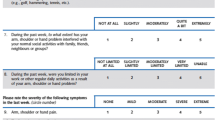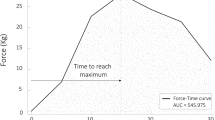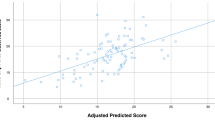Abstract
Objective
Fibromyalgia, a potentially debilitating chronic pain syndrome, is a chronic disease. We aimed to compare the hand function of fibromyalgia (FM) patients and healthy individuals and to demonstrate the relationship between hand disability and FM.
Patients and methods
The study was consisted of 40 female patients with FM and 30 healthy controls. All participants were evaluated for pain threshold measurements, handgrip strength, and pinch strength. Functional states, hand disability, and hand skills and coordination were evaluated using the Fibromyalgia Impact Questionnaire (FIQ) form, the Disability of Arm–Shoulder–Hand (DASH) questionnaire and the Purdue Pegboard Test, respectively.
Results
Handgrip strength values, DASH score, lateral pinch strength test, Pegboard placement time, and Pegboard collection time of the patient group were significantly lower than those of the control group (all p < 0.05). A negative correlation was found between FIQ score and handgrip strength, two-point pinch strength test, three-point pinch strength test, and lateral pinch strength test in patients with moderate FM (all p < 0.05). Furthermore, a correlation was observed between DASH score and handgrip strength, lateral pinch strength test, Purdue Pegboard placement time, and Purdue Pegboard collection time in patients with moderate FM (all p < 0.05).
Conclusions
Our results show that hand function was decreased in patients with FM compared to healthy controls and decreasing hand function was influenced by FIQ score. As a result, the evaluation of hand function should be taken into consideration in the management of FM.
Zusammenfassung
Ziel
Fibromyalgie, ein potenziell beeinträchtigendes chronisches Schmerzsyndrom, ist eine chronische Krankheit. Ziel der Autoren war es, die Handfunktion von Patienten mit Fibromyalgie (FM) und gesunden Personen zu vergleichen und den Zusammenhang zwischen Funktionseinschränkungen der Hand und FM zu demonstrieren.
Patienten und Methoden
Die Gruppe der Studienteilnehmer bestand aus 40 weiblichen Patienten mit FM und 30 gesunden Kontrollen. Alle Teilnehmer wurden auf Schmerzschwellenmessungen, Griffkraft und Daumenkraft untersucht. Funktionszustand, Funktionseinschränkungen der Hand sowie Fingerfertigkeit und -koordination wurden anhand des Fibromyalgia Impact Questionnaire (FIQ), des Fragebogens Disabilities of Arm, Shoulder and Hand, (DASH, Arm-Schulter-Hand-Fragebogen) bzw. des Purdue-Pegboard-Tests (Stecktafel) beurteilt.
Ergebnisse
Handgriffkraftwerte, DASH-Score, lateraler Daumenkrafttest, Pegboard-Platzierungszeit und Pegboard-Sammelzeit der Patientengruppe waren signifikant niedriger als die der Kontrollgruppe (alle p < 0,05). Eine negative Korrelation wurde zwischen FIQ-Score und Griffkraft, 2‑Punkt-Daumenkrafttest, 3‑Punkt-Daumenkrafttest und dem lateralen Daumenkrafttest bei Patienten mit mittelschwerer FM gefunden (alle p < 0,05). Darüber hinaus wurde eine Korrelation zwischen dem DASH-Score und der Handgriffkraft, dem lateralen Daumenkrafttest, der Purdue-Pegboard-Platzierungszeit und der Purdue-Pegboard-Sammelzeit bei Patienten mit mittelschwerer FM beobachtet (alle p < 0,05).
Schlussfolgerungen
Die Ergebnisse der Autoren zeigen, dass die Handfunktion bei FM-Patienten im Vergleich zu gesunden Kontrollen abnahm und die Verminderung der Handfunktion durch den FIQ-Score beeinflusst wurde. Daher sollte die Beurteilung der Handfunktion bei der Behandlung der FM berücksichtigt werden.
Similar content being viewed by others
References
Wolfe F, Häuser W (2011) Fibromyalgia diagnosis and diagnostic criteria. Ann Med 43(43):495–502
Kuppens K, Neels H, Wilgen CP et al (2015) Do illness perceptions in patients with fibromyalgia differ across countries? A comparative study. Myopain 23(1–2):13–20
Wolfe F, Ross K, Anderson J et al (1995) The prevalence and characteristics of fibromyalgia in the general population. Arthritis Rheum 38(1):19–28
Koca TT, Tanrikut E, Arslan A et al (2016) The effect of fibromyalgia syndrome to gravidity, parity and duration of breastfeeding; a prospective study from Turkey. Pak J Med Sci 32(3):545–549
Staud R, Rodriguez ME (2006) Mechanisms of disease: pain in fibromyalgia syndrome. Nat Clin Pract Rheumatol 2(2):90–98
Bellato E, Marini E, Castoldi F et al (2012) Fibromyalgia syndrome: etiology, pathogenesis, diagnosis, and treatment. Pain Res Treat 2012:426130
Clauw DJ (2009) Fibromyalgia: An overview. Am J Med 122(12):S3–S13
Henriksen M, Lund H, Christensen R et al (2009) Relationships between the fibromyalgia impact questionnaire, tender point count, and muscle strength in female patients with fibromyalgia: a cohort study. Arthritis Rheum 61(6):732–739
Harman H, Ones K, Ayna AB (2015) The effects of handgrip strength and clinical findings to quality of life in fibromyalgia syndrome. J Orthop Res Physiother 11:19
Maquet D, Croisier JL, Renard C et al (2002) Muscle performance in patients with fibromyalgia. Joint Bone Spine 69(3):293–299
Koklu K, Sarıgul M, Ozisler Z et al (2016) Handgrip strength in fibromyalgia. Arch Rheumatol 31(2):158–161
Sahin G, Ulubas B, Calikoglu M et al (2004) Handgrip strength, pulmonary function tests, and pulmonary muscle strength in fibromyalgia syndrome: is there any relationship? South Med J 97(1):25–29
Jones J, Rutledge DN, Jones KD et al (2008) Self-assessed physical function levels of women with fibromyalgia: a national survey. Womens Health Issues 18(5):406–412
Wolfe F, Clauw DJ, Fitzcharles MA et al (2010) The American College of Rheumatology preliminary diagnostic criteria for fibromyalgia and measurement of symptom severity. Arthritis Care Res 62(5):600–610
Sarmer S, Ergin S, Yavuzer G (2000) The validity and realibility of the Turkish version of the fibromyalgia impact questionnaire. Rheumatol Int 20(1):9–12
Aparicio VA, Ortega FB, Heredia JM et al (2011) Handgrip strength test as a complementary tool in the assessment of fibromyalgia severity in women. Arch Phys Med Rehabil 92(1):83–88
Turkyilmaz AK, Kurt EE, Karkucak M et al (2012) Sociodemographic characteristics, clinical signs and quality of life in patients with fibromyalgia. Eurasian J Med 44(2):88–93
Devrimsel G, Turyilmaz AK, Yildirim M et al (2015) The effects of whirlpool bath and neuromuscular electrical stimulation on complex regional pain syndrome. J Phys Ther Sci 27(1):27–30
Haidar SG, Kumar D, Bassi RS et al (2004) Average versus maximum grip strength: which is more consistent? J Hand Surg 29(1):82–84
Mathiowetz V, Kashman N, Volland G et al (1985) Grip and pinch strength: normative data for adults. Arch Phys Med Rehabil 66(2):69–74
Halpern CA, Fernandez JE (1990) The effect of wrist and arm postures on peak pinch strength. J Hum Ergol (Tokyo) 25(2):115–130
Wewers ME, Lowe NK (1990) A critical review of visual analogue scales in the measurement of clinical phenomena. Res Nurs Health 13(4):227–236
Hudak PL, Amadio PC, Bombardier C (1996) Development of an upper extremity outcome measure: the DASH (disabilities of the arm, shoulder and hand). The Upper Extremity Collaborative Group (UECG). Am J Ind Med 29(6):602–608
Kitis A, Celik E, Aslan UB (2009) DASH Questionnaire for the analysis of musculoskeletal symptoms in industry workers: a validity and reliability study. Appl Ergon 40(2):251–255
Buddenberg LA, Davis C (2000) Test retest reliability of the Purdue pegboard test. Am J Occup Ther 54(5):555–558
Hawley DJ, Wolfe F (1991) Pain, disability and pain/disability relationships in seven rheumatic disorders. J Rheumatol 18(10):1552–1557
Littlejohn G (2015) Neurogenic neuroinflammation in fibromyalgia and complex regional pain syndrome. Nat Rev Rheumatol 11(11):639–648
Wortmann RL (1994) Searching for the cause of fibromyalgia: is there a defect in energy metabolism? Arthritis Rheum 37(6):790–793
Akyol Y, Ulus Y, Tander B et al (2013) Muscle strength, fatigue, functional capacity, and proprioceptive acuity in patients with fibromyalgia. Turk J Phys Med Rehab 59:292–298
Panton LB, Kingsley JD, Toole T et al (2006) A comparison of physical functional performance and strength in women with fibromyalgia, age- and weight-matched controls, and older women who are healthy. Phys Ther 86(11):1479–1488
Nordenskiöld UM, Grimby G (1993) Grip force in patients with rheumatoid arthritis and fibromyalgia and in healthy subjects: a study with the Grippit instrument. Scand J Rheumatol 22(1):14–19
Mannerkorpi K, Svantesson U, Broberg C (2006) Relationships between performance-based tests and patients’ ratings of activity limitations, self-efficacy, and pain in fibromyalgia. Arch Phys Med Rehabil 87(2):259–264
Sañudo B, Galiano D (2009) Using cardiovascular parameters and symptom severity to prescribe physical activity in women with fibromyalgia. Clin Exp Rheumatol 27(5 Suppl 56):62–66
Aparicio VA, Carbonell-Baeza A, Ortega FB et al (2010) Handgrip strength in men with fibromyalgia. Clin Exp Rheumatol 28(6 Suppl 63):S78–S81
Puente CP, Furlong VL, Gallardo E et al (2015) Self-efficacy and affect as mediators between pain dimensions and emotional symptoms and functional limitation in women with fibromyalgia. Pain Manag Nurs 16(1):60–68
Weigent DA, Bradley LA, Blalock JE et al (1998) Current concepts in the pathophysiology of abnormal pain perception in fibromyalgia. Am J Med Sci 315(6):405–412
Mannerkorpi K, Burckhardt CS, Bjelle A (1994) Physical performance characteristics of women with fibromyalgia. Arthritis Care Res 7(3):123–129
Cardoso FS, Curtolo M, Natour J et al (2011) Assessment of quality of life, muscle strength and functional capacity in women with fibromyalgia. Rev Bras Reumatol 51(4):338–350
Author information
Authors and Affiliations
Corresponding author
Ethics declarations
Conflict of interest
G. Devrimsel, A. K. Turkyilmaz, M. S. Beyazal and M. Karkucak declare that they have no competing interests.
All procedures performed in studies involving human participants were in accordance with the ethical standards of the institutional and/or national research committee and with the 1975 Helsinki declaration and its later amendments or comparable ethical standards. Informed consent was obtained from all individual participants included in the study.
Additional information
Redaktion
U. Müller-Ladner, Bad Nauheim
U. Lange, Bad Nauheim
Rights and permissions
About this article
Cite this article
Devrimsel, G., Turkyilmaz, A.K., Beyazal, M.S. et al. Assessment of hand function and disability in fibromyalgia. Z Rheumatol 78, 889–893 (2019). https://doi.org/10.1007/s00393-018-0558-7
Published:
Issue Date:
DOI: https://doi.org/10.1007/s00393-018-0558-7




